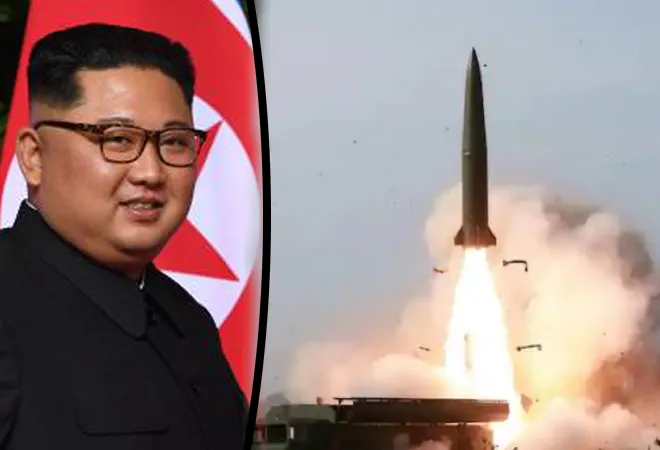-
CENTRES
Progammes & Centres
Location
How will the new Biden administration respond to the missile tests conducted by North Korea? Will it follows Trump’s top-down approach or will it follow a more traditional diplomatic approach?
 Tensions have ratcheted up in the Korean Peninsula after both the North and South conducted missile tests in the of a few days. The tests, which follow closely on the heels of weeks of steadily escalating provocations from the North, underscore just how strained the security situation has become in the region.
To begin with, North Korea has been busy. In the last few weeks, North Korea has restarted a previously dormant nuclear facility, tested a new cruise missile and launched ballistic missiles that landed in the Sea of Japan. This flurry of provocations, simply the latest in the long saga of the Hermit Kingdom’s nuclear drama, are aimed at an audience of one: Joe Biden.
In late August, the International Atomic Energy Agency (IAEA) reported that it had detected suspicious activity from North Korea’s Yongbyon Nuclear Plant. Long a mainstay of the reclusive nation’s nuclear programme, Yongbyon had been temporarily shuttered in 2018 in the heyday of Kim Jong Un’s bonhomie with then-President Trump as a token of the dictator’s commitment to reaching a settlement on his nuclear arsenal with the United States. While no longer as crucial to North Korea’s nuclear plans as it once was, Yongbyon remains the nation’s only source of plutonium and tritium, both key elements for manufacturing the cutting-edge thermonuclear weapons North Korea hopes to build, adding to the dread of the rest of the region.
Tensions have ratcheted up in the Korean Peninsula after both the North and South conducted missile tests in the of a few days. The tests, which follow closely on the heels of weeks of steadily escalating provocations from the North, underscore just how strained the security situation has become in the region.
To begin with, North Korea has been busy. In the last few weeks, North Korea has restarted a previously dormant nuclear facility, tested a new cruise missile and launched ballistic missiles that landed in the Sea of Japan. This flurry of provocations, simply the latest in the long saga of the Hermit Kingdom’s nuclear drama, are aimed at an audience of one: Joe Biden.
In late August, the International Atomic Energy Agency (IAEA) reported that it had detected suspicious activity from North Korea’s Yongbyon Nuclear Plant. Long a mainstay of the reclusive nation’s nuclear programme, Yongbyon had been temporarily shuttered in 2018 in the heyday of Kim Jong Un’s bonhomie with then-President Trump as a token of the dictator’s commitment to reaching a settlement on his nuclear arsenal with the United States. While no longer as crucial to North Korea’s nuclear plans as it once was, Yongbyon remains the nation’s only source of plutonium and tritium, both key elements for manufacturing the cutting-edge thermonuclear weapons North Korea hopes to build, adding to the dread of the rest of the region.
North Korea has restarted a previously dormant nuclear facility, tested a new cruise missile and launched ballistic missiles that landed in the Sea of Japan.Only a short while after, North Korean state media reported that the nation’s defence establishment had successfully tested a new cruise missile. The missile, state media crowed, was a “strategic weapon”, Pyongyang-speak for a potentially nuclear capable device. With this addition to its already substantial and growing armoury, the belligerent state has further complicated defence and strategic calculations for the United States, Japan, and South Korea. This was followed swiftly by a ballistic missile launch that ended up in the Sea of Japan and sent alarm bells ringing in regional capitals. This launch, conducted with the aid of a railway-based missile launcher, has had both analysts and government officials sit up and take notice. By diversifying its missile launch and delivery systems, North Korea hopes to improve the survivability of its substantial arsenal. American and South Korean military detection and intelligence assets will now have to map out North Korean rail infrastructure in an attempt to locate and, in the event of an emergency, target these delivery systems. Given the numerous North Korean military assets that Seoul and Washington already monitor, this new development places additional strain on the ability of the two allies to detect and respond to provocations from their troublesome northern enemy. Table: North Korean Tests and Weapons Displays North Korea’s missile inventory.
| Date | Tests |
| October 2020 | Military parade that displays new and improved Hwasong ballistic missile and new Submarine Launched Ballistic Missile (SLBM) |
| March 25, 2021 | North Korea carried out test-launch of two upgraded KN-23 short-range ballistic missiles carrying a 2.5 live warhead each that correctly hit the simulated targets |
| 11th and 12th September 2021 | New long-range cruise missile tested which flew for 1,500 kilometres and were termed “strategic” weapons (euphemism for nuclear capable) |
| 15 September 2021 | Ballistic missile fired through new railway borne system and lands in Japan’s Exclusive Economic Zone |
North Korea also displayed its version of a Submarine Launched Ballistic Missile, which was also recently acquired by Seoul to great fanfare in the international media.
North Korea’s nuclear weapons not only provide an effective deterrent against potential US military action on the Korean peninsula but also allow a struggling and destitute state to deal on equal terms with the world’s most powerful nation.Nevertheless, Biden does have room for creative statecraft. While the US can continue to call for complete denuclearisation in principle, Biden’s team may consider negotiating a phased arms control agreement. Such an agreement would set clear and specific timelines for North Korean actions like the dismantling of Yongbyon and a moratorium on new weapons development and testing. Once the US and allied partners like South Korea verify compliance, sanctions relief and economic investment could be provided to the regime in Pyongyang. To be sure, such a deal would not be perfect by any stretch. It would require a thorough inspection regime which Pyongyang has been reluctant to allow in the past. Further, it would undoubtedly raise the hackles of Biden’s conservative opponents at home. However, such a deal would allow Biden to succeed where Trump failed by recognising a simple truth: While the United States can no longer roll back Pyongyang’s nuclear status, it can creatively shape the regime’s capabilities in a way that diminishes the threat to America and its allies. Given what is at stake for global security, one can only hope that the Biden team steps up to the mark.
The views expressed above belong to the author(s). ORF research and analyses now available on Telegram! Click here to access our curated content — blogs, longforms and interviews.

Shashank Mattoo was a Junior Fellow with the ORFs Strategic Studies Program. His research focuses on North-East Asian security and foreign policy.
Read More +